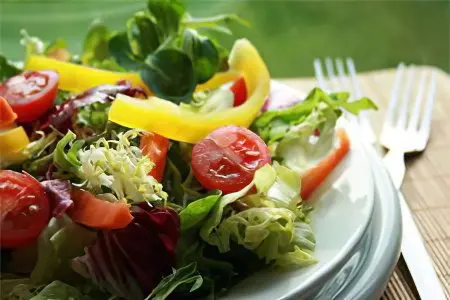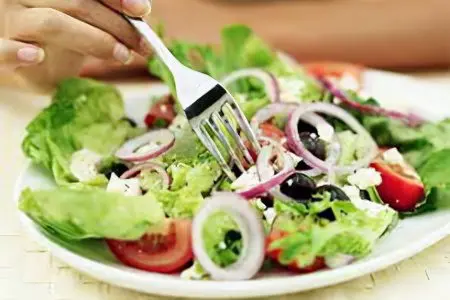Contents
Osteochondrosis is a disease that can be caused by a number of factors and is characterized by degenerative changes in the intervertebral disc, with further spread to its other departments, as well as to the entire musculoskeletal system in general, and to the nervous system in particular. Naturally, like any other disease, osteochondrosis requires medical treatment and adherence to certain nutritional rules.
What can you eat with osteochondrosis?

Since increased body weight gives an increased load on the spine, nutrition should be organized in such a way that it does not contribute to gaining extra pounds.
Therefore, it is important to include foods in the menu that take a long time to digest, do not cause hunger and help cleanse the intestines:
Any vegetables and fruits that have undergone minimal heat treatment.
Lean meat, chicken is best.
Eggs, but you need to be limited to 3 pieces per week.
Fish and seafood.
Cereal porridge.
Dairy products: cottage cheese, sour cream, kefir, low-fat cheeses, sour cream.
Fresh berries, except grapes.
Nuts: almonds, hazelnuts, chestnuts, walnuts.
Dried fruits.
Pasta, but always from durum wheat.
What can not be eaten with osteochondrosis?
In addition to healthy foods that help control weight and improve the condition of a patient with osteochondrosis, there are also harmful foods and drinks.
What should be avoided in case of degenerative spine disease:
Carbonated drinks.
Strong black tea and coffee.
Alcohol.
A pastry made from white wheat flour.
Sweet products.
Grape.
Sorrel.
Legumes – peas, chickpeas, lentils, beans.
Fat meat.
Semi-finished products.
Salt needs to be limited.
Nutrition for osteochondrosis can be varied, but it is necessary to exclude from it all products that are harmful even for a healthy person.
Menu for a week with osteochondrosis
It is important to correctly distribute the time for snacks, breakfast, lunch and dinner, so that the total number of meals is at least 5. It is advisable to boil, stew or steam all foods, but not fry.
1 day
The first breakfast consists of low-fat cottage cheese seasoned with sour cream, no more than 15% fat, with dried apricots. As a drink – green tea, second brew, without sugar.
As a snack, you can use a fresh apple.
For lunch: pumpkin soup, buckwheat porridge with steamed chicken cutlets, a piece of bran bread, rosehip juice.
For an afternoon snack: fruit salad (kiwi, banana, apple) with yogurt dressing.
For dinner: steamed hake fillet with boiled brown rice, vegetable salad (cabbage, carrot, cucumber, passed through a grater) with lemon juice and soy sauce dressing, herbal tea.
A glass of fat-free yogurt, it is better to use 30 minutes before bedtime.
2 day
The first breakfast consists of an egg omelette in a water bath and a glass of green tea.
An orange can be used as a snack.
For lunch: onion soup, rice porridge and chicken breast fillet baked in foil with aromatic herbs, vegetable salad (tomatoes, olives, green onions, olive oil), dried fruit compote.
For dinner: fish soufflé with mashed potatoes, fresh or frozen berry juice.
Before going to bed, you need to drink a glass of fermented baked milk.
3 day

Breakfast can consist of a casserole with broccoli, egg and cheese, as well as a glass of herbal tea.
For second breakfast, you can use a banana.
For lunch: fish soup from any low-fat fish, chicken pilaf, vegetable salad (Beijing cabbage, fresh cucumber, lemon juice, olive oil, dill and green onions), fresh fruit compote.
For dinner: pasta with vegetables (carrots, bell peppers, zucchini, tomato, eggplant), berry juice, a handful of nuts with honey.
A glass of serum will be an excellent end to the day of a person suffering from osteochondrosis.
4 day
Oatmeal with peach, green tea – this should be the first breakfast.
You can use an avocado as a snack.
For lunch: Soup based on chicken meatballs. Flounder in a double boiler with vegetables (potatoes, carrots, pumpkin), baked apple with cottage cheese, honey and nuts. Morse from berries.
For dinner: casserole with egg, potatoes and cheese, compote of fresh apples and cherries.
Before going to bed – a glass of low-fat yogurt.
5 day
You need to start the morning with steam cheesecakes and green tea of the second tea leaves.
As a snack, you can use a fruit salad (apple, kiwi, banana, nectarine, with yogurt dressing) and a piece of low-fat cheese with bran bread.
For lunch: Mushroom puree soup (mushrooms, carrots, potatoes, onions, garlic), tilapia fillets with asparagus cooked in foil in the oven, prunes and dried apricots compote.
For dinner: chicken soufflé with rice, fruit jelly, berry juice, a handful of almonds.
It is best to end day 5 with a glass of kefir with a minimum fat content.
6 day
A snack after a full-time rest consists of lazy dumplings with cottage cheese and bran and green tea as a drink.
For the second breakfast – plum jelly.
For lunch: Millet soup with vegetables (carrots, potatoes, onions), steamed turkey cutlets with vegetable stew (tomatoes, zucchini, bell peppers, eggplant), dried fruit compote.
For dinner: vegetable salad (radish, celery, cucumber, linseed, sunflower oil), buckwheat with fish in a pot, berry juice.
Before going to bed: low-fat cottage cheese with sour cream and raisin dressing.
7 day

Muesli with berries, bran bread with cheese, a glass of cocoa without sugar.
For second breakfast, you can eat grapefruit and a handful of hazelnuts.
For lunch: celery soup, vegetable salad (vinaigrette without pickled cucumber), steamed chicken fillet with rice, dried fruit compote.
For dinner: potatoes with grenadier and tomatoes in the oven with cheese, cottage cheese with cinnamon, cranberry juice.
Before going to bed – a glass of fermented baked milk.
A properly composed menu is a guarantee that a person suffering from osteochondrosis will not gain extra pounds and will not aggravate the course of the disease.
There are many diets, but when choosing any of them, it is important to focus on four basic rules:
Eat fractionally, at least five times a day.
End the day with a low-fat dairy drink.
Minimize food processing before consumption.
Try not to exceed the norm of 2500 kcal per day (sometimes you need 500 kcal less, and sometimes more, depending on the person’s lifestyle).









